Switching away from gas lawn mowers to keep your lawn in shape has never been easier. The best battery-powered electric lawn mowers now have legit gas-replacement performance, better runtime, and more innovative features than any lawn mower available a few years ago. We’ve been testing cordless mowers on our lawns for over a decade, and we can tell you firsthand that they keep improving.
I’m going to walk you through my top recommendations in the four main classes of battery-powered lawn mowers: push, self-propelled, lawn tractor, and zero-turn. For self-propelled and zero-turn mowers, I’ll include professional and residential options. Along the way, I’ll also point out the things I look for when evaluating electric lawn mowers.
Not sure where to start? Click here to jump down and learn the best brands and key decision factors.
Best Battery-Powered Electric Lawn Mowers
- Best Push Mower: Ryobi 40V HP Brushless 21-inch Cross Cut – Buy at Home Depot
Jump to this Mower ↓ - Best Residential Self-Propelled: EGO 56V Aluminum 22-inch Select Cut – Buy at Acme Tools
Jump to this Mower ↓ - Best Commercial Self-Propelled: Greenworks Commercial 30-inch – Buy at Greenworks
Jump to this Mower ↓ - Best for the Money: Skil PWRCore 40 20-inch Self-Propelled – Buy at Acme Tools
Jump to this Mower ↓ - Best Lawn Tractor: Ryobi 80V 46-inch Lawn Tractor – Buy at Home Depot
Jump to this Mower ↓ - Best Residential Zero-Turn: Greenworks MaximusZ – Buy at Walmart
Jump to this Mower ↓ - Best Commercial Zero-Turn: Greenworks Commercial OptimusZ – Buy at Greenworks
Jump to this Mower ↓
Also In This Article
- More Standout Battery-Powered Electric Lawn Mowers
- More Options From Brands We Trust
- What We Look For on Battery-Powered Electric Lawn Mowers
- Why Buy a Battery-Powered Electric Lawn Mower?
- Related Content
- Why Trust Pro Tool Reviews
Best Residential Battery-Powered Electric Push Lawn Mower
Ryobi 40V HP Brushless 21-Inch Cross Cut RY401200
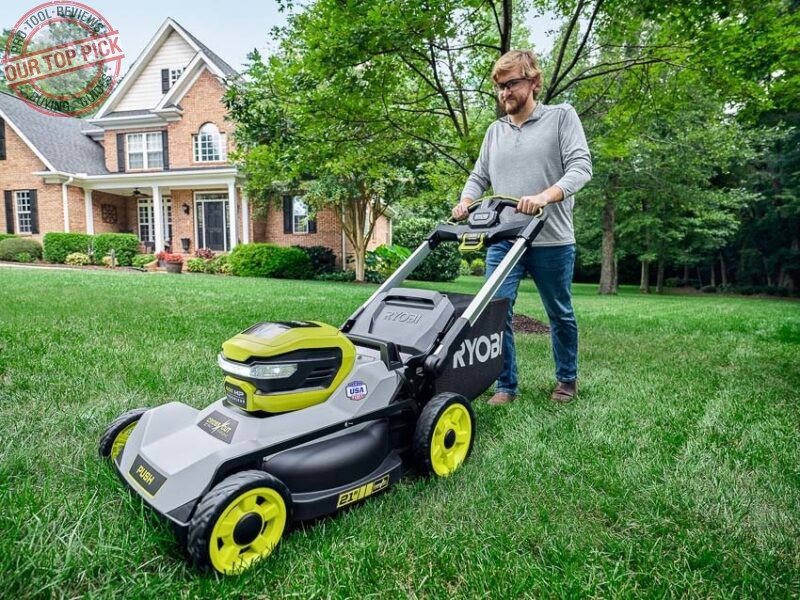
When Ryobi unleashed the Cross Cut mower series, the design team didn’t just focus on improving the power. In addition to its 170cc+ gas equivalent performance, the Cross Cut push mower acts more like a gas mower than many models we’ve tested. It shows up primarily in how well it distributes the grass when using the side discharge. It’s a much broader throw that doesn’t clump out.
The bagging and mulching are excellent as well. We could see the difference in the amount of grass we collected in the bag and the size of the clippings when we mulched. What’s great is that Ryobi offers three versions of the Cross Cut. You can expect the same great performance if you want the lower price of the push mower version, a rear-wheel-drive, or all-wheel-drive.
Reasons to Buy
- Excellent cutting power
- Stacked blade system improves cut quality
- Outstanding side discharge distribution
- Excellent mulching and bagging
- LED headlights
- Folds up for vertical storage
- Batteries are compatible with all Ryobi 40V products
- Lifetime deck and 5-year mower warranty with registration
- Made in the USA using global materials
Consider Another Model If…
- You want a self-propelled model
- You’re on a smaller mower budget
- Your lawn is less than 1/8-acre
Key Decision Factors
| Deck Size/Material | 21-inch poly |
| Gas Equivalent Power | 170cc+ |
| Torque | Not listed |
| Maximum Blade Speed/Tip Speed | Not listed |
| Cutting Height | 1.5 – 4 inches (7 positions) |
| Maximum Runtime | 50 minutes (7.5Ah battery) |
| Cutting Options | Mulch, bag, side discharge |
| PTR’s Recommended Lawn Size | Up to 18,333 sq ft (0.42 acres) |
| Maximum Lawn Coverage | Up to 23,100 sq ft (0.53 acres) |
Price: $549
Best Residential Electric Battery-Powered Self-Propelled Lawn Mower
EGO 22-Inch Aluminum Select Cut Self-Propelled Lawn Mower LM2200SP
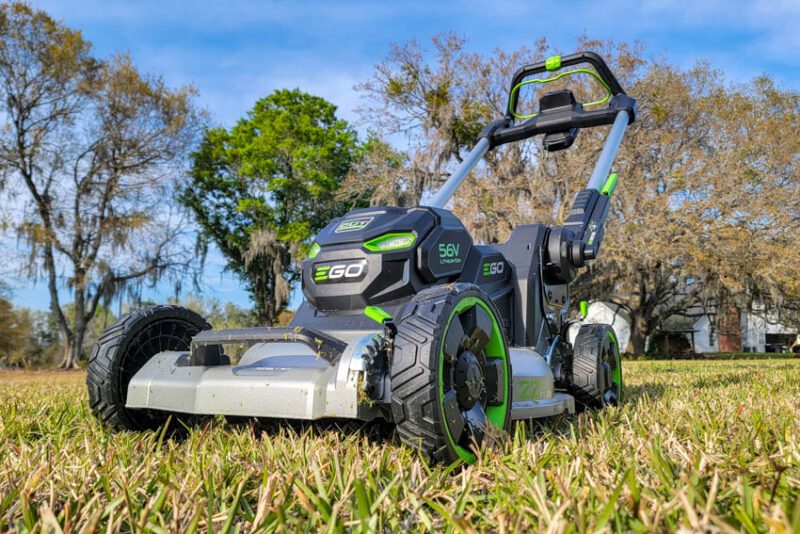
After EGO’s latest mower developments reached a performance level worthy of replacing gas, you wouldn’t blame them for taking a little break and enjoying the fruits of their labor. That’s not the EGO way, and new for 2024, they’re stepping up again with a 22-inch aluminum deck self-propelled mower.
Generating the most interest is the power level—11.1 ft-lbs of torque. That’s not just the highest we’ve ever tested in a battery power walk-behind lawn mower, it’s well over what we expect from 200cc+ gas engines. With its performance plus an aluminum deck and the return to EGO’s easy-to-use Touch Drive system, this mower feels more Pro than residential.
Reasons to Buy
- Most powerful cordless self-propelled mower we’ve tested
- Generous discharge/bagging chute significantly reduces clogging
- Excellent mulching and bagging
- Stacked blade system improves cut quality
- Select Cut system lets you optimize for lift or runtime
- Three cutting modes to match the conditions
- Easy on-the-fly drive speed adjustments
- LED headlights
- Folds up for vertical storage
- Batteries are compatible with all EGO 56V products
- Lifetime deck, 5-year mower, and 5-year battery warranty with registration
Consider Another Model If…
- You don’t have the budget for a premium mower
- Your lot is less than 1/8-acre
Key Decision Factors
| Deck Size/Material | 22-inch aluminum |
| Gas Equivalent Power | 200cc+ |
| Torque | 11.1 ft-lbs |
| Maximum Blade Speed/Tip Speed | 3,350 RPM/18,400 FPM |
| Cutting Height | 1 – 4 inches (8 positions) |
| Maximum Runtime | 70 minutes (10.0Ah battery) |
| Drive Speed | 0.9 – 3.1 MPH |
| Cutting Options | Mulch, bag, rear discharge |
| PTR’s Recommended Lawn Size | Up to 25,667 sq ft (0.59 acres) |
| Maximum Lawn Coverage | Up to 33,418 sq ft (0.77 acres) |
Price: $1,199
Best Commercial Battery-Powered Electric Self-Propelled Lawn Mower
Greenworks Commercial 82V 30-inch 82LM30S
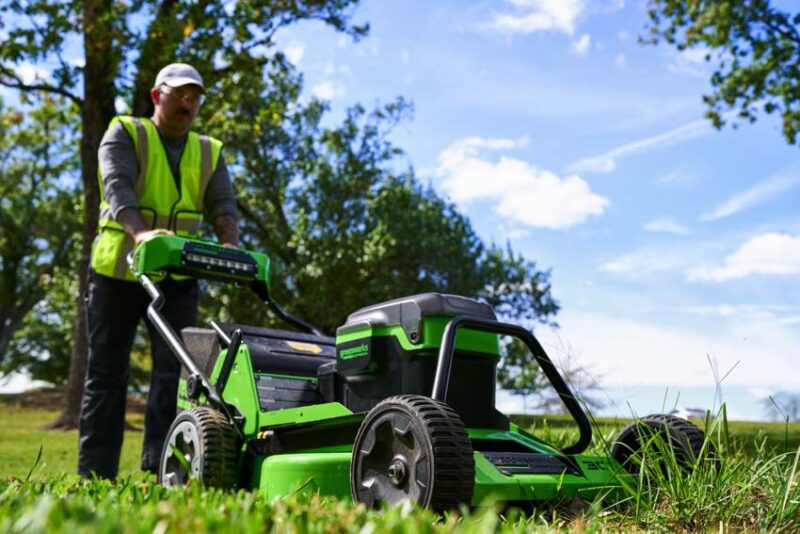
At Equip Expo 2022 (formerly GIE), we got our hands on the Greenworks Commercial 30-inch lawn mower for the first time. As the first in the 30-inch class for the commercial market, it’s a revelation for Pros who have been skeptical of battery power.
As we saw from the 25-inch version, the mower uses two side-by-side blades to achieve its cutting width. Thanks to brushless technology, it cuts with a blade tip speed of 16,000 FPM, making for clean cuts and efficient bagging/mulching and exceeding the power of a 200cc gas engine.
It’s smart, too, as it takes advantage of 4G coverage to provide GPS tracking. On the “why didn’t they do that sooner?” list, it has a reverse function for its independent hub wheel motors.
After using it, there’s no doubt the performance is solid, and the features are helpful for commercial crews. The final piece of the puzzle is how the design team beefed up the components to ensure it has the durability Pros need for their primary walk-behind mower.
Reasons to Buy
- Strong cutting performance
- Impressive runtime with full battery loadout
- Outstanding coverage per charge
- Powered reverse function
- Large collection bag
- Side rails prevent accidentally pressing control toggle switches
- Robust commercial build
- LED headlights
- Batteries are compatible with all Greenworks Commercial 82V products
Consider Another Model if…
- You need a side/rear discharge function
- You don’t want to manage multiple chargers to charge all three batteries at once
- You’re not on a premium budget
Key Decision Factors
| Deck Size/Material | 30-inch steel |
| Gas Equivalent Power | 200cc |
| Torque | Not listed (3.5Kw peak power) |
| Maximum Blade Speed/Tip Speed | 4,000 RPM/16,150 FPM |
| Cutting Height | 1.5 – 4 inches (8 positions) |
| Maximum Runtime | 110 minutes (3 x 8.0Ah battery) |
| Drive Speed | Up to 3.8 MPH |
| Cutting Options | Mulch, bag |
| PTR’s Recommended Lawn Size | Up to 56,467 sq ft (1.30 acres) |
| Maximum Lawn Coverage | Up to 88,894 sq ft (2.04 acres) |
Price: $3,499.99
Best Battery-Powered Electric Lawn Mower for the Money
Skil PWRCore 40 20-Inch Self-Propelled Lawn Mower Skil SM4910-10
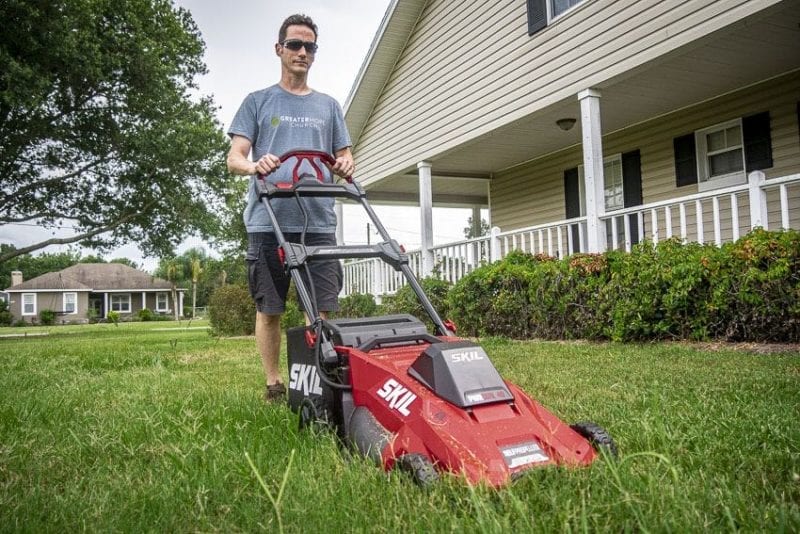
Here’s the challenge: find a brushless self-propelled lawn mower with a battery and charger for under $400. When it comes to the brands we trust, there aren’t many options.
However, Skil saves the day and offers plenty of value with its 20-inch self-propelled lawn mower. Running on the stronger PWRCore 40 line, this brushless mower has excellent all-around performance and cut-quality characteristics compared to others in the same price range. If you’re trying to switch to battery power on a budget, Skil offers the best value self-propelled lawn mower available.
Reasons to Buy
- Excellent value
- Self-propelled
- Lightweight for its size
- Folds up for vertical storage
- Easy on-the-fly drive speed adjustments
- Batteries are compatible with all Skil PWRCore 40 products
Consider Another Option if…
- You’re looking for premium cutting power
- You’re looking for premium cut quality
Key Decision Factors
| Deck Size/Material | 20-inch poly |
| Gas Equivalent Power | 140cc |
| Torque | Not listed (3.5Kw peak power) |
| Maximum Blade Speed/Tip Speed | 2,600 RPM/13,267 FPM |
| Cutting Height | 1.5 – 4 inches (7 positions) |
| Maximum Runtime | 52 minutes (6.0Ah battery) |
| Drive Speed | Not listed |
| Cutting Options | Mulch, bag |
| PTR’s Recommended Lawn Size | Up to 17,637 sq ft (0.40 acres) |
| Maximum Lawn Coverage | Up to 18,590 sq ft (0.43 acres) |
Price: $349
Best Battery-Powered Electric Lawn Tractor
Ryobi 80V HP Brushless 46-inch Lawn Tractor RYRM8070
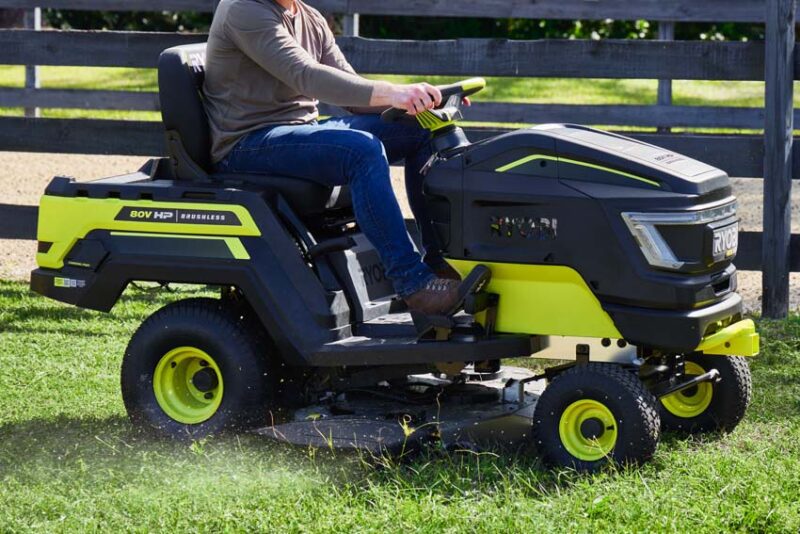
Now that the battery-powered zero-turn competition is settling into its stride, we’re starting to see some excellent improvements for those who want an electric lawn tractor. Ryobi sets itself apart in several ways.
First, there’s the performance. With 23 HP gas equivalent power and three sets of Cross Cut blades to improve the cut quality, its primary role of maintaining your lawn gets an A+. The runtime is also better than its closest competitors, covering up to 2.5 acres on a charge.
Where it sprints across the finish line is in its other characteristics. It has an excellent towing capacity with front and rear hitch receivers. Add in its bed for hauling material, and you have a true multi-purpose utility vehicle to help you maintain your entire landscape.
If you have a smaller lawn or tight storage needs, Ryobi also has a 42-inch model of this mower available.
Reasons to Buy
- Impressive cutting power
- Multiple drive and blade speed settings
- All three blades are stacked Cross Cut blades that improve cut quality
- Fabricated 10-gauge steel deck
- Versatile design that can mow, haul, and tow
- Front and rear hitch receivers
- 500-lb towing capacity
- Larger deck covers more lawn per charge
- Informative, easy-to-use LCD control panel in front of the steering wheel
- Compatible with Ryoni’s Riding Mower App via Bluetooth
- LED headlights
- USB charging ports
- Onboard charging
- 5-year warranty on the mower, batteries, and charger
- Made in the USA using global materials
Consider Another Model if…
- You don’t have a premium budget
Key Decision Factors
| Deck Size/Material | 46-inch fabricated 10-gauge steel |
| Gas Equivalent Power | 23 HP |
| Torque | Not listed |
| Maximum Blade Speed/Tip Speed | Not listed |
| Cutting Height | 1.5 – 4.5 inches (13 positions) |
| Maximum Runtime | Not listed |
| Drive Speed | Up to 7.0 MPH |
| Cutting Options | Mulch, bag, side discharge |
| Maximum Lawn Coverage | Up to 2.50 acres |
Price: $4,999
Best Residential Battery-Powered Electric Zero-Turn Lawn Mower
Greenworks 60V MaximusZ 60-inch Zero-Turn
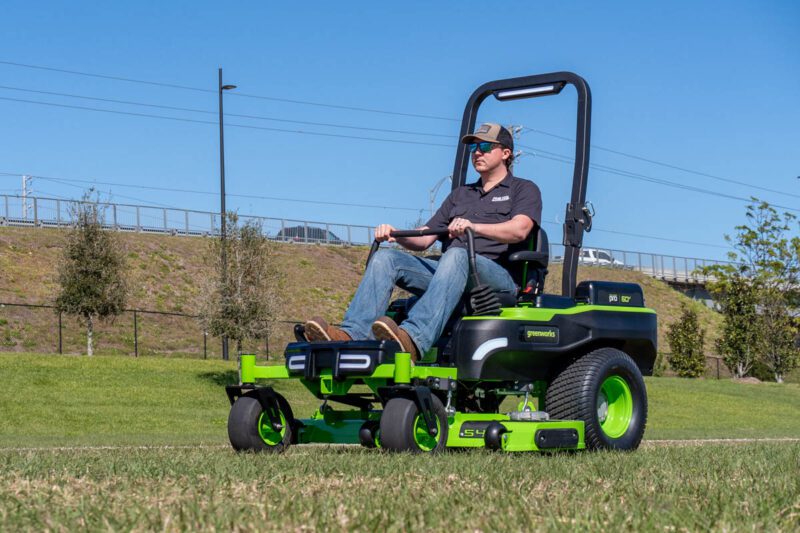
Just when it looked like EGO and Ryobi were running away in the battery-powered residential zero-turn competition, Greenworks stepped up with its MaximusZ. Looking around the mower, you can see that it looks like a gas zero-turn with a beefier build than many of its competitors.
When you sit down, kick on the blades, and push the lap bars forward, you can feel the 31 HP engine equivalent delivering the performance we’re used to seeing from gas models—without the noise and emissions, of course.
It’s also packed with helpful features. Some of the major highlights include a dump bed, an electronic take-off port for accessories, and 4G cellular connectivity to address theft protection and remote diagnostics. And that’s just scratching the surface.
There’s no doubt in my mind that if you’re looking to make the switch from a gas-powered zero-turn to a battery-powered one, the MaximusZ is the most direct replacement that also happens to add helpful features you won’t find on a gas model.
The MaximusZ is also available in a 54-inch version.
Reasons to Buy
- More robust build than other residential ZTs
- Impressive cutting power
- Excellent lawn coverage per charge
- Dump bed with 200-lb capacity
- 300-lb towing capacity
- Front ETO accessory port
- Front and rear hitch receivers
- Standard Greenworks 60V batteries can be used to extend runtime
- LED headlights
- ROPS bar
- USB charging ports
- Onboard charging
- 4G connectivity for diagnostics and theft protection
Consider another model if…
- You don’t want lap bars for control
- You’re looking for a smaller riding mower
Key Decision Factors
| Deck Size/Material | 60-inch fabricated steel |
| Gas Equivalent Power | 31 HP |
| Torque | Not listed |
| Maximum Blade Speed/Tip Speed | 17,000 FPM |
| Cutting Height | 1.5 – 4.5 inches (14 positions) |
| Maximum Runtime | 130 minutes (2 x 20Ah suitcase + 4 x 8.0Ah battery) |
| Drive Speed | Up to 8.0 MPH |
| Cutting Options | Side discharge |
| Maximum Lawn Coverage | Up to 5.0 acres |
Price: $6,497
Best Commercial Battery-Powered Electric Zero-Turn Lawn Mower
Greenworks Commercial 60-inch OptimusZ 24kWh Zero-Turn
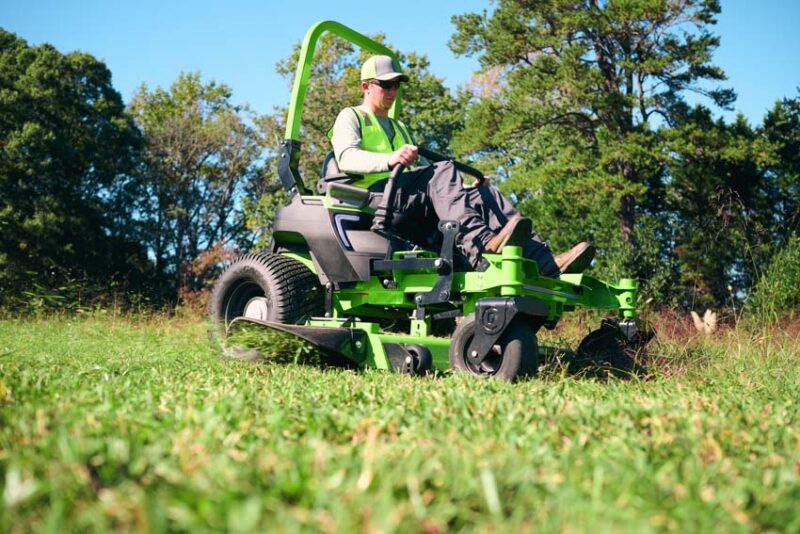
At Equip Expo 2023, it was clear that Pros have more battery-powered ride-on lawn mowers than ever, and more are coming. Greenworks revealed its second generation as it moves from the Lithium Z mowers to the Optimus Z line and embraces a whole-system approach.
Currently, the top of the range is the 60-inch OptimusZ, but there’s a 72-inch model in the works as well. There are a ton of smart and useful features built in. However, the bottom line is that this mower drives and cuts like a gas ZT with no compromise.
The Optimus Z zero-turn mower is also available with an 18kWh battery, along with 48-inch and 52-inch deck sizes. There are stand-on models as well, offering professional crews everything they need to stay on one platform.
Greenworks unveiled a concept trailer to support a 100% battery-powered crew, including up to three ride-on/stand-on mowers. Taking it a step further, the team is working on a version of the OptimusZ that can run with an operator or fully autonomous. We got to see a working prototype at Equip Expo.
In terms of a 100% battery, one-brand focus for professionals, Greenworks Commercial has the advantage over every other brand we’ve seen in the commercial space.
Reasons to Buy
- Outstanding cutting power
- Outstanding lawn coverage
- Robust commercial build
- Touchscreen display
- 4G connectivity for theft protection and remote diagnostics
- ETO system for accessories up to 10 HP
- ROPS bar
- LED headlights and safety lights
- USB charging ports
- Onboard charging
- 5-year, 2,000-hour warranty
- Assembled in the USA
Consider Another Model if…
- You’re on a sub-$25k budget
Key Decision Factors
| Deck Size/Material | 60-inch fabricated 7-gauge steel |
| Gas Equivalent Power | 65 HP |
| Torque | Not listed |
| Maximum Blade Speed/Tip Speed | 19,000 FPM |
| Cutting Height | 1 – 5 inches (17 positions) |
| Maximum Runtime | 8 hours |
| Drive Speed | Up to 16 MPH |
| Cutting Options | Side discharge |
| Maximum Lawn Coverage | Up to 21 acres |
Price: $26,999.99
More Standout Battery-Powered Electric Lawn Mowers
Echo 56V 21-Inch Self-Propelled Lawn Mower DLM-2100SP
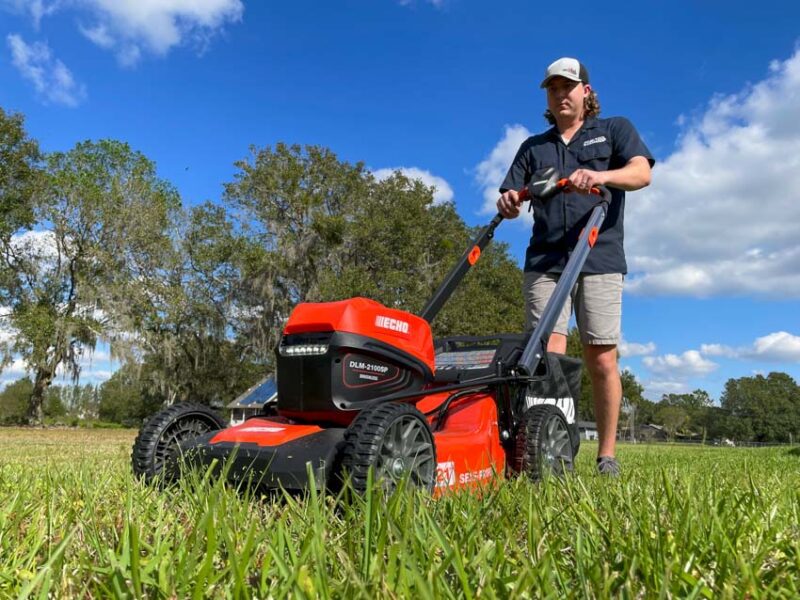
ECHO phased out its 58V battery lineup in favor of a completely new 56V eForce line (sorry, the old batteries are not compatible with the new tools) and that includes a new mower, the self-propelled DLM-2100SP. It’s a solid design that presses all the right buttons and makes for a well-rounded machine. It doesn’t challenge the power levels of the top performers, but it doesn’t have their price tags, either. This no-nonsense mower earns its place on our list because of its value.
| Deck Size/Material | 21-inch steel |
| Gas Equivalent Power | 160cc |
| Torque | Not rated |
| Maximum Blade Speed/Tip Speed | 3,200 RPM/16,747 FPM |
| Cutting Height | 1 – 4 inches (7 positions) |
| Maximum Runtime | up to 70 minutes (5.0Ah battery) |
| Drive Speed | 1.35 – 2.95 MPH |
| Cutting Options | Mulch, bag, side discharge |
| PTR’s Recommended Lawn Size | up to 24,383 sq ft (0.56 acres) |
| Maximum Lawn Coverage | up to 30,287 sq ft (0.70 acres) |
Price: $549
Milwaukee M18 Fuel 21-Inch Self-Propelled Lawn Mower 2823
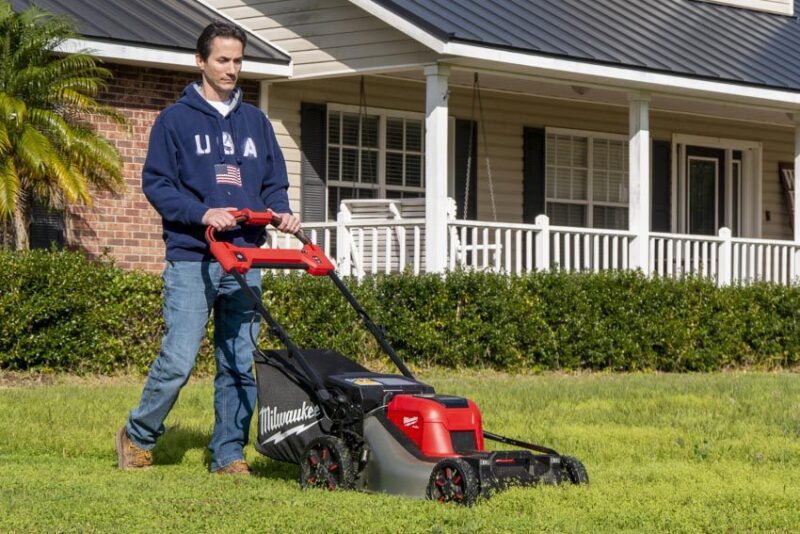
Boasting a monstrous 10 ft-lbs of torque (more than a 200cc gas engine!), Milwaukee’s M18 Fuel self-propelled lawn mower enjoyed a long reign as the most powerful electric option. Even now, it’s still the second strongest more than two years after our initial review.
Using a pair of 12.0Ah batteries, it can run for up to an hour in light conditions and we ran it for more than 40 minutes when taking off 4 – 6 inches of growth. If there’s a downside, it’s that the drive thumb bar introduces some thumb fatigue, but we were able to adjust our grip to deal with it.
The mower also has a tough build designed to handle professional use while offering the convenience of single-point height adjustments and vertical storage. While there are larger options available (such as Greenworks’ 82V 30-inch), Milwaukee’s price tag is much easier on your budget.
| Deck Size/Material | 21-inch steel |
| Gas Equivalent Power | 200cc+ |
| Torque | 10.0 ft-lbs |
| Maximum Blade Speed/Tip Speed | 3,300 RPM/18,133 FPM |
| Cutting Height | 1 – 4 inches (7 positions) |
| Maximum Runtime | 60 minutes (2 x 12Ah batteries) |
| Drive Speed | 0 – 4.0 MPH |
| Cutting Options | Mulch, bag, side discharge |
| PTR’s Recommended Lawn Size | 22,000 sq ft (0.51 acres) |
| Maximum Lawn Coverage | 36,960 sq ft (0.85 acres) |
Price: $1,099
Greenworks 60V 21-Inch Razor Cut Self-Propelled Lawn Mower 2546202
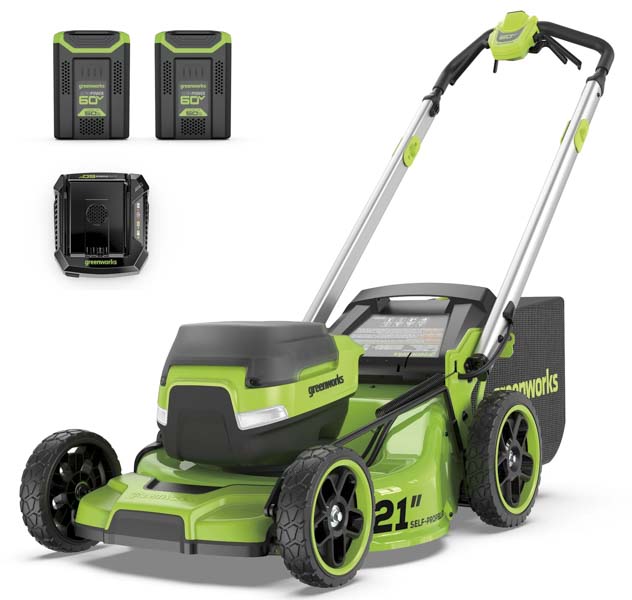
Greenworks announced its move into Walmart, and along with it, several new additions to its 60V platform. Among them is a stacked blade Razor Cut self-propelled mower.
We got a chance to use it for a few minutes but haven’t been able to put it through our full review process yet. Based on those initial impressions, I can tell it’s a nice upgrade from the previous versions on the 60V line. Even though there’s not a lot of information out yet, keep your eyes on this one as the new leader for the Greenworks 60V system.
| Deck Size/Material | 21-inch steel |
| Gas Equivalent Power | Not listed |
| Torque | Not listed |
| Maximum Blade Speed/Tip Speed | 3,200 RPM |
| Cutting Height | Not listed |
| Maximum Runtime | Up to 80 minutes (2 x 5.0Ah batteries) |
| Drive Speed | Not listed |
| Cutting Options | Mulch, bag, side discharge |
| Maximum Lawn Coverage | 43,560 sq ft (1 acre) |
Price: $648
Ryobi 80V HP Brushless Cross Cut 30-inch Self-Propelled Lawn Mower RYPM8010
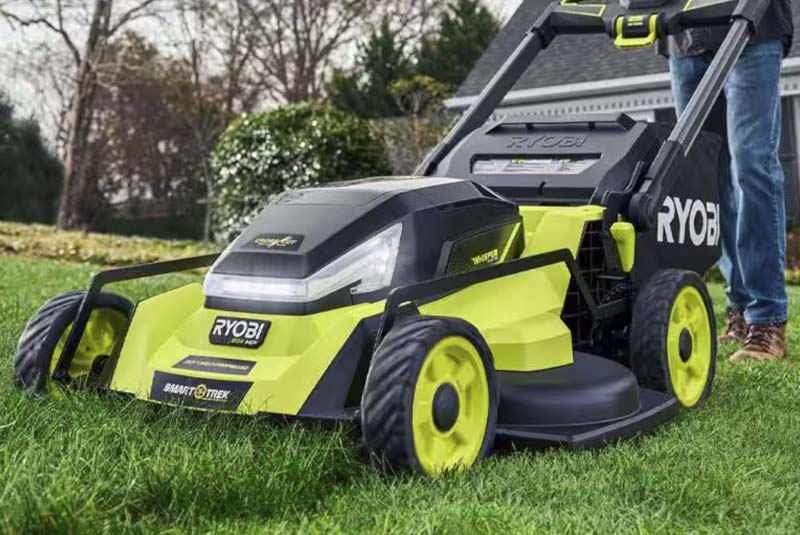
Folks with larger lawns who don’t want a riding mower have been asking for a large-deck self-propelled lawn mower that works on battery power. It’s taken a couple of years, but Ryobi has an 80V 30-inch self-propelled model that’s taking over the residential landscape.
Like the iDrive ride-on mowers, the 30-inch walk-behind uses an 80V suitcase-style battery for power. The brushless motors turn two sets of stacked Cross Cut blades, making for a total of four. By going that route, Ryobi keeps the overall blade mass down while achieving the large cutting width, performance, quality, and runtime it needs to get the job done. Plus, it’s made in the USA with global materials
| Deck Size/Material | 30-inch poly |
| Gas Equivalent Power | 223cc+ |
| Torque | Not listed |
| Maximum Blade Speed/Tip Speed | Not listed |
| Cutting Height | 1 – 4 inches (10 positions) |
| Maximum Runtime | Up to 90 minutes (10.0Ah battery) |
| Drive Speed | Not listed |
| Cutting Options | Mulch, bag, side discharge |
| Maximum Lawn Coverage | Up to 43,560 sq ft (1 acre) |
Price: $1,999
EGO 56V 42-inch Lawn Tractor TR4204
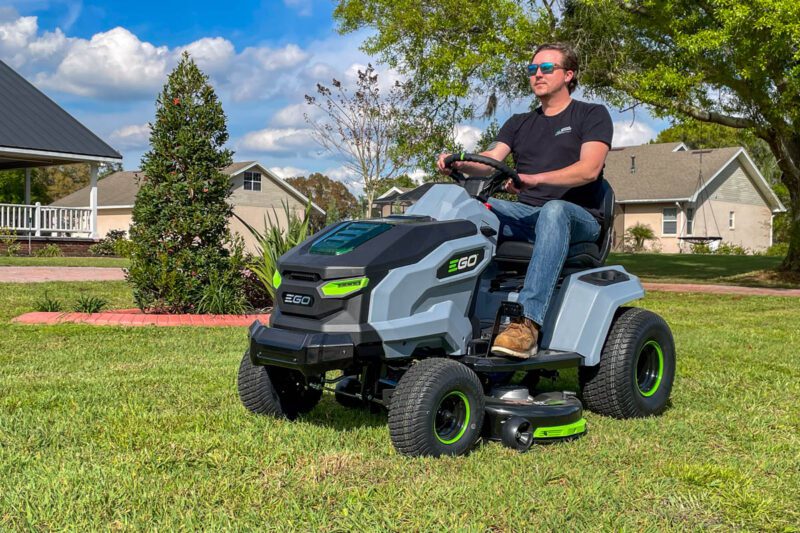
EGO’s lawn tractor offers a gas-like experience with a design that maintains the traditional lawn tractor look and feel. Its 21 HP gas equivalent power has no trouble keeping up with the demands of the 42-inch cutting deck, and there’s no chance you’ll miss the noise, emissions, and engine maintenance.
Adding to its appeal, all your controls are right in front of the steering wheel where you can view and access them easily. There are multiple drive and blade speed modes, allowing you to tune the mower to the conditions and make the most of your battery capacity. There are a host of other convenience features as well, such as USB charging ports, LED headlights, and more.
While this model isn’t quite as versatile as Ryobi’s, it’s an extremely capacity mower. Perhaps more importantly, EGO’s price tag is $1000 lower.
| Deck Size/Material | 42-inch steel |
| Gas Equivalent Power | 21 HP |
| Torque | Not listed |
| Maximum Blade Speed/Tip Speed | 3,000 RPM/16,485 FPM |
| Cutting Height | 1.5 – 4.5 inches (12 positions) |
| Maximum Runtime | Not listed |
| Drive Speed | Up to 6 MPH |
| Cutting Options | Mulch, side discharge, bag |
| Maximum Lawn Coverage | 1.5 acres |
Price: $3,999
EGO 56V E-Steer 42-inch Zero-Turn Lawn Mower ZT4205S
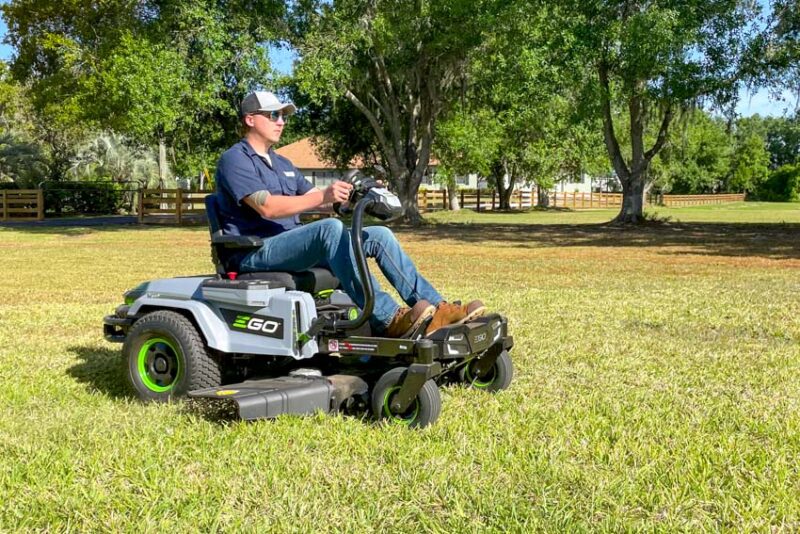
While some will argue EGO’s 54-inch zero-turn is the better option because of its wider deck, the EGO E-Steer is turning heads. It has a zero turning radius but uses a steering wheel rather than lap bars for turning. If the traditional lap bar steering system has been keeping you from going to a zero-turn model, this is your riding mower.
Even if you’re comfortable with lap bars, there’s still a reason to consider the E-Steer system. EGO shifted the control panel from the side of the mower to the center of the wheel. Now they’re conveniently in front of you where it’s easier to keep an eye on your battery status and make quick adjustments.
If we’re completely honest (and we always strive to be), it’s a heck of a lot of fun to drive. That’s enough to put it in the win column for many people.
| Deck Size/Material | 42-inch steel |
| Gas Equivalent Power | 22 HP |
| Torque | Not listed |
| Maximum Blade Speed/Tip Speed | 3,200 RPM/17,584 FPM |
| Cutting Height | 1.5 – 4.5 inches (10 positions) |
| Maximum Runtime | Not listed |
| Drive Speed | 4 – 8 MPH |
| Cutting Options | Mulch, bag, side discharge |
| Maximum Lawn Coverage | 2.5 acres w/included batteries 3.75 acres w/ six 12.0Ah batteries |
Price: $5,499
Ryobi 80V iDrive 54-inch Zero-Turn Lawn Mower RYRM8034
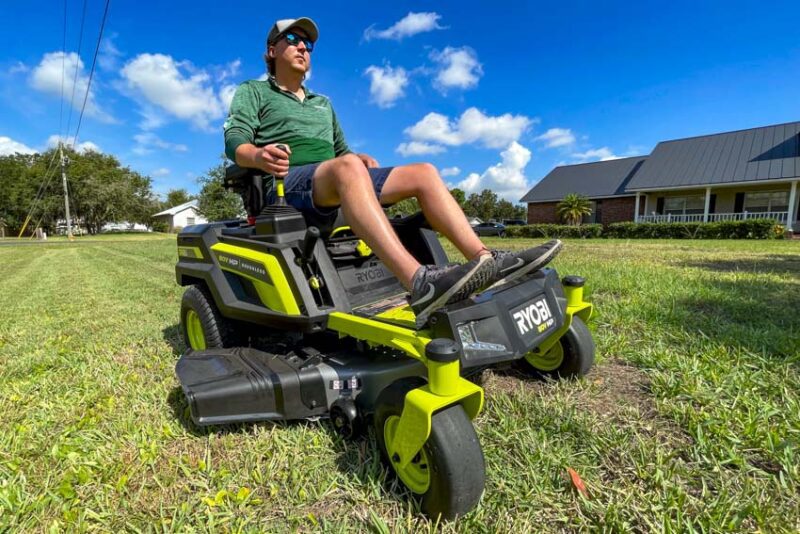
Ryobi is also joining the alternative control zero-turn group. Its line of 80V zero-turn lawn mowers features the iDrive system that uses joystick control. Whether you want to think of it as playing a video game or flying a grass-maintaining fighter jet, it doesn’t take long to get used to.
For its first-generation iDrive models, you have three deck sizes from which to choose: 30, 42, or 54 inches. They primarily use a suitcase-style 80V battery that can also be supplemented by 40V batteries to extend your runtime. With performance levels reaching up to that of a 42 HP gas engine, cutting power isn’t a problem.
| Deck Size/Material | 54-inch fabricated steel (10-gauge) |
| Gas Equivalent Power | 42 HP |
| Torque | Not listed |
| Maximum Blade Speed/Tip Speed | Not Listed |
| Cutting Height | 1.5 – 4.5 inches (12 positions) |
| Maximum Runtime | Not listed |
| Drive Speed | 4 – 8 MPH |
| Cutting Options | Mulch, side discharge (Bagging available for smaller versions) |
| Maximum Lawn Coverage | Up to 4 acres |
Price: $5,999
More Options From Brands We Trust
HART SuperCharge 40V Electric Battery-Powered Lawn Mower HLPM061US
HART stepped up with its Supercharge 40V brushless self-propelled mower, demonstrating that the brand can make a mower capable of cutting 3/4-acre lawns. The performance level is in the 160cc gas engine class thanks to two active battery ports and the two 6.0Ah batteries included in the kit. Compared to the mowers we’ve used from HART before, this is by far the most capable for those of you holding out for a mid-range gas replacement.
Price: $598.00 with two 6.0Ah batteries and a rapid charger
Husqvarna 40V Commercial Electric Battery-Powered Lawn Mowe W520Ir
Husqvarna launched a 20-inch commercial-grade 3-in-1 battery-powered self-propelled lawn mower with an aluminum deck and front bar to protect the battery/motor housing. The W520i notably is compatible with a battery backpack. It doesn’t fit as cleanly as Makita’s ConnectX since you still need to run an adapter into the battery slots, but it does take the weight off your back and keep you from being tethered. It also has a higher-than-normal cutting range that tops out at 4.5 inches.
Price: $1,299.99 bare
Take a look at Husqvarna’s Lawn Xpert mower—a Lowe’s exclusive for 2023!
Makita ConnectX Electric Battery-Powered Lawn Mower CML01
One of the biggest challenges with any battery-powered electric lawn mower is runtime. Makita put that problem squarely in its crosshairs and developed the ConnectX system. Unlike other designs, the 1200Wh power supply attaches directly to the top of the mower, offering more than 3x the capacity of most cordless mowers and running for up to 3 hours continuously.
Similar to the 18V X2 (36V) XML08, the mower tops out at 2800 RPM with a 2300 RPM Quiet Mode and has a true 21-inch steel deck.
Price: $1,099.00 bare, $1,399.00 power supply ($2,348.00 for both)
Stihl 36V Electric Battery-Powered Lawn Mower RMA 510 V
Stihl has been a little more cautious in entering the electric lawn mower market and upgraded the line with a couple of self-propelled models. Of the two available, the Stihl RMA 510 V is your top performer. It features a 21-inch steel deck (20-inch blade) with a tougher build than the 460 series and its 3.9-inch top cutting height is appropriate for taller grass species. The one downside is that this model runs through batteries quickly compared to other self-propelled mowers.
Price: $499.99 bare, $799.99 with AP 300 battery and charger
Did you know Stihl now has zero-turn lawn mowers?
Best Battery-Powered Electric Lawn Mower Brands
Residential Brands
- Craftsman
- DeWalt (select models)
- Echo
- EGO
- Greenworks
- HART
- Husqvarna (select models)
- John Deere
- Kobalt
- Masterforce
- Ryobi
- Skil
- Stihl (select models)
- Toro
- Worx
Professional Brands
- DeWalt (select models)
- Exmark
- Ferris
- Greenworks Commercial
- Husqvarna (select models)
- Makita
- Milwaukee
- Stihl (select models)
What We Look For on Battery-Powered Electric Lawn Mowers
Lawn Size and Mower Style
How much lawn you need to mow directly affects the best mower for the job. With battery power, you can keep popping fresh batteries in and keep going as long as you’re willing to tolerate it. I recommend walk-behind mowers for up to an hour based on a 2.5 MPH walking speed, which is what we’ve found to be comfortable in our testing. Here’s how that shakes out.
| Lot Size | Recommended Walk-Behind Cutting Width | Recommended Riding Cutting Width |
| < 1/8 acre | 16 – 20 inches | Not recommended |
| 1/8 – 1/4 acre | 18 – 21 inches | 30 – 36 inches |
| 1/4 – 1/2 acre | 20 – 21 inches | 30 – 42 inches |
| 1/2 – 3/4 acre | 25 – 30 inches | 30 – 42 inches |
| 3/4 – 1 acre | Not recommended | 42 – 54 inches |
| 1 – 2 acres | Not recommended | 54 – 60 inches |
| 2 – 3 acres | Not recommended | 60 inches |
| 3+ acres | Not recommended | 60 – 72 inches |
Power
Brushless motors make testing power much more challenging because of their ability to sense and adjust to the load the blade is experiencing. To gauge it, we cut an overgrown section of grass to a manageable height and follow it up by seeing how short we can cut an even standard-height section of grass.
The more effectively a battery-powered lawn mower can reclaim overgrowth and the shorter it can effectively cut a baseline height, the more working power it has.
Runtime
How much runtime an electric lawn mower has is only part of the equation. The best information is how much area you can cut on a charge. We start with a section of grass cut to a standard height and then see how long we can mow on one battery charge as we cut it down to 3 inches.
Once we know that, we calculate the maximum area you should be able to mow without having to stop and recharge.
Cut Quality
We test three basic areas of cut quality: evenness, bagging efficiency, and mulching efficiency.
Evenness is simple enough—we gauge how even the cut is by looking for blades that stick out and areas that may have been cut shorter than intended.
Bagging efficiency is a matter of seeing how much grass is left behind compared to the amount that is collected in the bag.
Mulching efficiency considers the size of the clippings the mower drops and whether it creates any clumping or trailing.
Build
We consider the quality of the build based on the materials and how well the mower is put together. We’re looking for solid components that will last well beyond the warranty period, rigid construction, and protection for the electrical components and batteries.
Hills, Slopes, and Uneven Terrain
Sure, it’s Florida and we don’t have many legit hills. But we do have sloped lakesides and ditches to go along with plenty of uneven ground. We drive or push our mowers to see how well they hold wheel traction mowing uphill, downhill, side-to-side, and bumping along.
Features
In addition to any standout features, here’s a list of the standard items we look for:
- Brushless motor
- Drive type and function
- Deck size
- Deck material
- Height adjustment
- Height range and number of levels
- Handle positions
- Discharge options
- Battery ports
Value
For our team of experts, value is much more than just price. It’s about what you get for what you pay. An expensive model may very well be the best battery mower value if it’s performing far enough ahead of the budget brands to justify it.
Additional Considerations
As you’re deciding on the best battery lawn mower for you in 2024, there’s a lot to consider. These electric mowers are a long way away from when we started with battery power.
What’s Your Budget?
While you can get a battery lawn mower for less than $300, plan on spending at least $500 for a quality model and more than $700 for the best electric lawn mowers.
That can cause a bit of a conflict. When you look at what you can get for the same price on a gas mower, you get more power and features from that gas engine. It won’t have the noise, emission, and maintenance benefits, though.
Are Battery Riding Mowers Viable?
There are a few riding mowers available for both professional and homeowner use. Professional crews have options such as Greenworks’ Lithium Z zero-turn (they also have a battery-powered UTV).
Homeowners have more choices with well-known brands Ryobi, Cub Cadet, and EGO (along with several others) providing a handful of zero turns and more traditional lawn tractors.
The models we’ve tested work well and do the job they’re designed for. However, there are two key trade-offs you need to keep in mind. One, there’s a big premium on the cost compared to a gas model. Two, you need to plan for long charge times. However, premium models are beginning to include legitimately fast chargers for their high-capacity batteries.
A third consideration is simply that this class of electric lawn mower is still relatively new. It’s possible to keep a gas model running for 10 years or more and repower it if necessary. With a full electric power plant, we simply don’t know what kind of service life to expect with proper maintenance.
As battery technology continues to move forward, keep your eyes open for the first graphene or silicon lithium batteries. They’re able to charge much faster than standard lithium-ion or lead-acid batteries and have the potential to get you back in the saddle quicker.
Residential or Commercial Quality?
On the surface, there’s not a dramatic difference between commercial-quality and residential-quality walk-behind battery lawn mowers.
At the high end, power doesn’t seem to vary much (though Milwaukee just changed that expectation). In fact, one of the most powerful mowers we’ve tested—EGO’s 22-inch Select Cut XP—is technically a residential model.
What commercial battery mowers have going for them is a design and feature set that’s much more tuned in to what professionals ask for. Some of that is merely the difference between what homeowners and professional crews prefer on a mower. However, there are differences in the quality of the components that brands choose for their separate lines. Commercial mowers must be ready for far more service hours each week.
Brands such as Greenworks Commercial, Husqvarna, and Stihl rely on their dealer networks rather than big box stores. You get additional support during and after the sale that you won’t find at other retailers.
Electric riding mowers are a completely different ballgame. With those, you’ll find a much greater difference in design and performance, along with a massive gap in cost.
Self-Propelled vs Push
Considering a self-propelled drive doesn’t have a huge effect on your runtime, it’s a feature you should get if it’s in your budget. Look for variable speed controls and try working it in the store before you bring it home. You can usually tell in just a few minutes if it’s comfortable and natural for your hands.
Look for a mower that disengages its drive easily when you want to pull the mower back. Some systems have a hard time letting go and force you to drag the drive wheels rather than allowing them to roll.
Let’s not completely rule out the classic push mower style, though. When you’re on a budget, you can easily save $100 or more without losing cutting performance if you’re willing to carry more of the workload.
If that’s the direction you’re heading, look for a poly deck to help reduce weight and wheels with bearings and low rolling resistance to make your job a little easier.
Self-Propel Drive Adjustment
Our testing team generally prefers a variable speed dial separate from the presence bar. Taking a different approach, Toro’s Personal Pace and Ryobi’s Smart Trek systems offer a self-adjusting speed that some folks like.
As you’re trying different adjustment styles, look for one that’s on the stiffer side or has positive stops. This will reduce the chances of accidentally knocking it to a different speed if your hand hits it or the terrain is bumpy.
Keep an eye on the location of the dial as well. Front and center placement is convenient to adjust on the fly. However, some people hit that position with their hand or hip as they turn. If that’s you, you might prefer your adjustment on the side, so you don’t accidentally change your speed with each turn.
Steel vs Poly Deck
In the gas-powered world, there are really no poly decks—most are either steel or aluminum. The cordless lawn mower world is much different with poly decks in every direction.
Steel is more durable, but it’s very unlikely you’re going to wear through a poly deck over the life of your battery-powered lawn mower. Poly also has an advantage in design. It’s much easier to make subtle changes in the shape that optimizes airflow for better lift, mulching, and bagging than a steel deck.
As we said, steel is more durable. If you have a lot of small rocks you kick up when you’re mowing or perhaps your teenager doesn’t pay quite as much attention as you’d like, then a steel deck can extend your mower’s life. Plus, it just looks good.
Bag, Mulch, or Side Discharge?
You probably already know whether you prefer to mulch or bag. Here in central Florida, we usually mulch to return nutrients to the lawn and avoid stopping every 10 minutes (literally) to dump the bag.
Sometimes, you go on vacation or the weather prevents you from hitting your normal mowing day. That’s when side (or rear) discharge becomes helpful.
Instead of keeping the grass up in the deck for finer mulching, it kicks it out. You could bag it, of course, but you’d spend a lot of time emptying it. For the sake of getting your cut back under control, side discharging can help keep you moving along when your grass gets long.
Look for a mower that gives you all three options and keep that side discharge chute somewhere handy just in case you need it.
Deck and Blade Size
Most of the best electric lawn mower models have 20 or 21-inch deck sizes with slightly smaller blades (Several brands list the actual blade diameter rather than the deck diameter).
There are smaller models appropriate for smaller lawns or areas with a lot of landscaping to work around.
There are also larger models. Greenworks Commercial and Greenworks 60V both have 25-inch models available. Battery-powered riding mowers run up to 52 inches or more on the residential side and 74 inches for commercial use.
The larger deck sizes are most helpful on lawns over 1/4-acre where they offer more considerable time savings. For lawns 1/4-acre or less, the standard 20 or 21-inch deck is usually fine.
Single Point vs Multi-Point Deck Height Adjustment
There’s no doubt that a single-point height adjustment is more convenient than adjusting each wheel. The relatively lighter weight of cordless lawn mowers also makes it a more viable solution.
Don’t completely discount two or four-point adjustments, though. A four-point system typically has a more rigid construction than a single-point design. Plus, you can kick your front wheels one notch higher than the rear to improve your bagging efficiency.
This one is really about what your preference is. We find most people set their height once and leave it, so a four-point system may not be all that bad from a convenience standpoint.
Multiple Battery Ports
If you have a lawn that’s more than 1/3 of an acre, there’s a good chance you can benefit from multiple battery ports. There are three possibilities: a second storage port, a second active port with a manual switch, and a second active port with automatic switching.
Automatic switching is the most convenient and usually comes on higher-priced mowers. Manual switching and simple storage take some extra effort, but not as much as going back to the garage or trailer for another battery.
Height Range
The majority of electric lawn mowers have all the height range you need to cover a wide variety of grass species. If you prefer to cut at heights over 3-1/2 inches or under 2 inches, just double-check that the mower you’re looking at covers it.
Why Buy a Battery-Powered Electric Lawn Mower?
The best battery-powered electric lawn mower for you should get your lawn cut on one charge. No matter which model that is, they all share some common characteristics. There are no gas emissions and no gas engine to maintain. You still need to clean it off when you’re done, but the maintenance is much easier and takes less time.
They’re also quieter. The early bird gets the worm and if you want to start mowing at 7:00 on Saturday morning, your neighbors can probably sleep through it. More of a night owl? Many battery-powered mowers have headlights, and you’re unlikely to disturb your neighbor’s Lord of the Rings marathon at 10:00 PM.
Those are some of the more obvious reasons, but one of our favorites is the ability to put the battery in and mow. There’s no cranking, no choke, and no fuel cut-off valve. As long as you have enough batteries to get the entire lawn cut, it’s an easier system to work with than gas.
Related Content
- Best Self-Propelled Lawn Mowers
- Proper Lawn Mower Care and Maintenance
- Switching from Gas to Battery-Powered Lawn Care Equipment
- Gas vs Battery-Powered Lawn Mowers
- How to Care for Your Lawn
Why You Can Trust Pro Tool Reviews to Recommend Battery-Powered Electric Lawn Mowers
The are a whole lot of publications and authors out there trying to convince you that they know what the best battery-powered electric lawn mower is for your home or business. Let’s give credit where credit is due—they use good SEO writers and may have even used a few popular mowers in the process.
But do they have more than a decade of experience using lawn mowers with an eye on comparative evaluation, understand the key features to look for, and have they experienced the differences in the quality of components in the field? Have they been around to see advances in performance, the development of innovative new features, and how battery power is finally getting the attention of professionals?
We have. We’ve been testing and reviewing lawn mowers for more than a decade, and they’re a necessary tool for every property that has a lawn to maintain.
So, you can take the advice of whatever Big Media company decided to offer product reviews designed first and foremost to rank for Google, written by someone who may or may not understand the full landscape of what’s available. Don’t forget to check up on breaking news, updates on the weather, and play a few games while you’re there.
Or you can trust Pro Tool Reviews because tools are what we do. When I recommend a lawn mower for you, it’s because it’s the one I would buy. My primary motivation is to recommend what I genuinely believe is the best in each category based on more than a decade of experience and being involved in the power tool and outdoor power equipment industries every day. And if you choose to buy something I recommend, I hope that it works exactly the way you expected when the time comes.
That’s how I hope to earn your trust. Not because I work for a high-profile media company with massive name recognition. But because I’m like you, and when I choose to make a purchase, I see the dollars come out of my bank account. I expect those products to work when I need them. I want authentic recommendations when I’m shopping, and I’m committed to offering you the best of my experience and knowledge when you see my name as the author.



